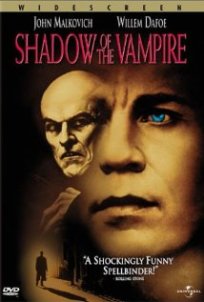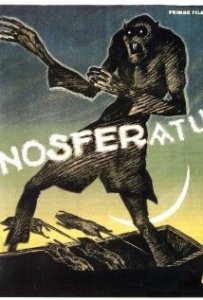I wanted to start doing this thing on Sunday nights here, where I force myself to sit my ass down, watch an interesting movie, and actually sit through it without getting sidetracked by all the other weird little projects I’m working on. Like this blog. So I combined the two. I started with an old french film a couple of weeks ago but then things got super busy at work and then i had to go on a road trip. It’s Sunday again and I have nothing better to do, so tonight I’ll be doing a double feature:
Nosferatu (1922)
Shadow of the Vampire (2000)

Here’s why:
When I woke up this morning this was the first article that caught my attention on my Twitter feed, from The Verge: Grave robbers steal Nosferatu director’s head from German cemetery.
What the actual fucking fuck did I just read? Ok, lets start the flicks…
The one about Dracula, here’s a quick synopsis via Wikipedia…
The film, shot in 1921 and released in 1922, was an unauthorized adaptation of Bram Stoker‘s Dracula, with names and other details changed because the studio could not obtain the rights to the novel (for instance, “vampire” became “Nosferatu” and “Count Dracula” became “Count Orlok”). Stoker’s heirs sued over the adaptation, and a court ruling ordered that all copies of the film be destroyed. However, a few prints of Nosferatusurvived, and the film came to be regarded as an influential masterpiece of cinema.[1][2] As of 2015, it is Rotten Tomatoes‘ second best-reviewed horror film of all time.[3]
TL;Dr (Spoiler Alert):
Thomas Hutter lives in the fictitious German city of Wisborg. His employer, Knock, sends Hutter to Transylvania to visit a new client named Count Orlok. Hutter entrusts his loving wife Ellen to his good friend Harding and Harding’s sister Annie, before embarking on his long journey. Nearing his destination in the Carpathian mountains, Hutter stops at an inn for dinner. The locals become frightened by the mere mention of Orlok’s name and discourage him from traveling to his castle at night, warning of a werewolf on the prowl. The next morning, Hutter takes a coach to a high mountain pass, but the coachmen decline to take him any further than the bridge as nightfall is approaching. A black-swathed coach appears after Hutter crosses the bridge and the coachman gestures for him to climb aboard. Hutter is welcomed at a castle by Count Orlok. When Hutter is eating dinner and accidentally cuts his thumb, Orlok tries to suck the blood out, but his repulsed guest pulls his hand away.
Hutter wakes up to a deserted castle the morning after and notices fresh punctures on his neck, which he attributes to mosquitoes or spiders. That night, Orlok signs the documents to purchase the house across from Hutter’s own home. Hutter writes a letter to his wife and gets a coachman to send it. Reading a book about vampires that he took from the local inn, Hutter starts to suspect that Orlok is Nosferatu, the “Bird of Death.” He cowers in his room as midnight approaches, but there is no way to bar the door. The door opens by itself and Orlok enters, his true nature finally revealed, and Hutter falls unconscious. The next day, Hutter explores the castle. In its crypt, he finds the coffin in which Orlok is resting dormant. Hutter becomes horrified and dashes back to his room. Hours later from the window, he sees Orlok piling up coffins on a coach and climbing into the last one before the coach departs. Hutter escapes the castle through the window, but is knocked unconscious by the fall and awakes in a hospital.
When he is sufficiently recovered, he hurries home. Meanwhile, the coffins are shipped down river on a raft. They are transferred to a schooner, but not before one is opened by the crew, revealing a multitude of rats. The sailors on the ship get sick one by one; soon all but the captain and first mate are dead. Suspecting the truth, the first mate goes below to destroy the coffins. However, Orlok awakens and the horrified sailor jumps into the sea. Unaware of his danger, the captain becomes Orlok’s latest victim when he ties himself to the wheel. When the ship arrives in Wisborg, Orlok leaves unobserved, carrying one of his coffins, and moves into the house he purchased. The next morning, when the ship is inspected, the captain is found dead. After examining the logbook, the doctors assume they are dealing with the plague. The town is stricken with panic, and people are warned to stay inside.
There are many deaths in the town, which are blamed on the plague. Knock, who had been committed to a psychiatric ward, escapes after murdering the warden. The townspeople give chase, but he eludes them by climbing a roof, then using a scarecrow. Meanwhile, Orlok stares from his window at the sleeping Ellen. Against her husband’s wishes, Ellen had read the book he found. The book claims that the way to defeat a vampire is for a woman who is pure in heart to distract the vampire with her beauty all through the night. She opens her window to invite him in, but faints. When Hutter revives her, she sends him to fetch Professor Bulwer. After he leaves, Orlok comes in. He becomes so engrossed drinking her blood that he forgets about the coming day. When a rooster crows, Orlok vanishes in a puff of smoke as he tries to flee. Ellen lives just long enough to be embraced by her grief-stricken husband. The last scene shows Count Orlok’s ruined castle in the Carpathian Mountains, symbolizing the end of Count Orlok’s reign of terror.
…So I’m watching it now and it’s simply beautiful. I’m not really into silent movies nor vampires, but the techniques Murnau uses to make this film are ground breaking. He uses odd apertures, which make the frames compositionally different sometimes. Like a daylight outdoor scene will be a roundish vignette. The more well lit indoor scenes are I guess, the standard, depending on what TV and format you are watching it on. Being that it’s a silent film you get those dialogue plates inserted here and there to help the plot along, but Murnau goes beyond that by inserting plate shots of handwriting in the form of letters between characters. So that was pretty cool. There’s a few shots with early macrophotography like stuff under a microscope. Also cool. Keep in mind this film was made in 1921. And that’s about it on that one. It’s just a vampire movie, albeit a very early, very well crafted one.
Now the one about the guy who made a movie about a vampire (whose skull was recently stolen from a cemetary) and who (fictionally) hired a REAL fucking vampire to play the part of the vampire in a movie he really wanted to call Dracula – Based on the filming of the film Nosferatu. Here’s a quick synopsis via Wikipedia…
Shadow of the Vampire is a 2000 horror film directed by E. Elias Merhige and written by Steven Katz, and starring John Malkovich and Willem Dafoe. The film is a fictionalised account of the making of the classicvampire film Nosferatu, eine Symphonie des Grauens, directed by F. W. Murnau, in which the film crew begin to have disturbing suspicions about their lead actor. The film borrows the techniques of silent films, including the use of intertitles to explain elided action and iris lenses.[3]
TL;Dr (Spoiler Alert):
After filming scenes in a studio with leading actress Greta Schroeder, who is displeased about leaving Berlin, Murnau’s team travels to the remote inn where they will be staying and shooting further scenes. The landlady becomes distressed at Murnau removing crucifixes around the inn, and the cameraman, Wolfgang Muller, falls into a strange, hypnotic state. Gustav discovers a bottle of blood amongst the team’s food supplies, and Murnau delivers a caged ferret to a cellar in the middle of the night.
One night, Murnau rushes his team up to an old Slovak castle for the first scene with the vampire. Schreck appears for the first time, and his appearance and behavior impress and disturb them. The film’s producer, Albin Grau, suspects that Schreck is not a German theater actor, and is confused when Murnau tells him that he found Schreck in the castle. Soon after the completion of the scene, Wolf is found collapsed in a dark tunnel. Upon returning to the inn, the landlady appears frightened by his pale, weak appearance, and mutters “Nosferatu” while clutching at a rosary.
Whilst filming a dinner scene between Gustav and Count Orlok, Murnau startles Gustav, making him cut his finger with a bread knife. Schreck reacts wildly at the sight of the blood, and, urged on by Murnau, tries drinking from Gustav’s wound. Suddenly the generator powering the lights fails. When the lights return, Schreck has pinned Wolf to the floor, apparently draining his blood. Albin orders filming ended for the night, and the crew rushes from the castle, leaving Schreck behind. Schreck examines the camera equipment, fascinated by footage of a sunrise.
Schreck is in fact an actual vampire, and Murnau has struck a deal with him in order to create the most realistic vampire film possible. He has been promised Greta as a prize for completing the film, but remains difficult and uncooperative until the entire production is at his mercy. With Wolf near death, Murnau is forced to bring in another cinematographer, Fritz Arno Wagner. During Murnau’s absence, Albin and the film’s scriptwriter, Henrik Galeen, share a drink by a campfire, when Schreck approaches them. They invite him to join them, and question Schreck, believing he is still in character. They ask him when he became a vampire; Schreck replies that he cannot remember. Albin and Galeen reply that Dracula would not reply so, then ask Schreck what he thought of the novel. Schreck points out Dracula’s loneliness, and the flaw of Dracula remembering how to do everyday activities that he has not performed in centuries. Albin and Henrik suggest creating more vampires, but Schreck replies he is too old, and he seems to remember he could not anyway. When they ask how he became a vampire, Schreck starts to mention a tryst he had. A bat flies by and Schreck catches it, sucking its blood ecstatically. The others are impressed by what they assume is talented acting.
The production moves to Heligoland to film the final scenes, and Murnau, in a laudanum-induced stupor, admits Schreck’s true nature to Albin and Fritz. The two realise that they are trapped, leaving them no choice but to complete the film and give Greta to the vampire if they wish to survive. Greta becomes hysterical after noticing Schreck casts no reflection. Murnau, Albin and Fritz drug her, and film the scene as Schreck feeds on Greta, resulting in her death. However, the laudanum in her blood puts Schreck to sleep. At dawn, the remaining three attempt to open a door and let in sunlight to destroy Schreck. However, Schreck previously cut the chain, having learned of their trickery. Schreck kills Fritz and Albin while Murnau continues filming. The rest of the crew arrives in time to lift up the door and flood the set with sunlight, destroying Schreck while Murnau films his death.
Murnau completes the filming and calmly states “I think we have it.”
I LOVE THIS MOVIE. As a film buff, it has everything you could ask for. If you aren’t, you will still probably like it. I mean, come on, John Malkovich and Willem Dafoe for Christ’s sake (get it?). It’s a movie within a movie. A guy grabs a bat out the air in mid-flight and bites its head off. Most of the main characters die. Highly recommended. So I’m going to go watch that now. Happy Sunday.
